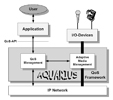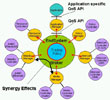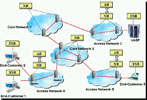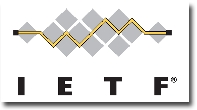| |
| | |
|
|
QoS - Quality of Service
How to specify Internet delivery parameters?
|
| | |
 Ubiquitous Computing Ubiquitous Computing
 Ubiquitous Media Ubiquitous Media
 Hybrary - Hybrid Library Hybrary - Hybrid Library
 Museum Technology Museum Technology
 Pervasive Gaming Pervasive Gaming
 Color Quantization Color Quantization
 Image Compression Image Compression
Quality of Service
 Intelligent Internet Services Intelligent Internet Services
 Seamless Media Adaptation Seamless Media Adaptation
 Supervised Theses Supervised Theses

|
Multimedia applications have become the driving force that is pushing the Internet into a widely
deployed, commonly accepted communication medium. As data transmission has become the dominant
transport issue of the traditional telephone system (PSTN), transmitting voice (or general audio
information) over the Internet (called IP telephony or sometimes simplified VoIP) has become
one of the most challenging research areas in the telecommunication industry. The same merger
between traditional circuit-oriented and modern packet-oriented networks can be seen in many
other media-related applications, like Video Conferencing, Multimedia Distance Learning,
Virtual Reality Group Chating, Secure online Shopping and Banking, Distributed Games and many more.
Quality of Service (QoS) describes mechanisms to ensure service oriented delivery
of packets in the original best-effort oriented Internet. Especially in the context
of realtime media transmission, ensured quality parameters for delay, jitter and loss
are required.
|
| | |



|
AQUARIUS
How to create a flexible QoS infrastructure?
AQUARIUS (Adaptive Quality of Service Architecture for Intelligent Universal Services) presents applications
with mechanisms for the processing and transmission of high quality
multimedia streams on demand. In addition, AQUARIUS provides a comprehensive QoS management system,
which hides the complexity of underlying network layer QoS technologies (e.g. DiffServ, IntServ, MPLS, etc.)
from the application and fulfills a broad range of mechanisms to realize additional QoS services, like adaptivity,
group conferencing, capability exchange functionality and many more.
Applications subscribe to the system and use the provided facilities via a respective API.
Since AQUARIUS provides a flexible mechanism to plug-in arbitrary components to capture, process, code,
transmit, receive, decode and display any kind of media, the application is shielded from that low-level complexity.
The AQUARIUS media API can be used to instantiate media sessions with an arbitrary number of streams
(a stream may also denote a locally processed media). The set-up of the media stream processing chain with
capture devices, codecs, effect processors, etc., can also be controlled via this API. In addition,
AQUARIUS offers appropriate graphical user interfaces to capture user QoS preferences (policy GUI) and
presenting media information (video renderer GUI).
|
| | |


|
Details about AQUARIUS can be found in:
Stefan Gessler, Oliver Haase and Andreas Schrader
High Quality Multimedia Services on Demand
Proceedings of the IEEE International Conference on Software in Telecommunications and Computer Networks
( SOFTCOM'2000),
Split, Rijeka, Croatia; Triest, Venice, Italy, October 10-14, 2000. SOFTCOM'2000),
Split, Rijeka, Croatia; Triest, Venice, Italy, October 10-14, 2000.
|
| | |



|
MASA
How to create a comprehensive QoS Infrastructure?
The MASA project (Mobility and Service Adaptation in heterogeneous mobile Environments) was a co-operation between NEC Europe Ltd.,
Siemens AG and the University of Ulm (Department for Distributed Systems) between 2001 and 2003. As a project leader of NEC,
I focused on the development of adaptive mechanisms for multimedia streaming over heterogeneous networks.
During the first phase of the project (1999-2000), the focus has been set to the adaptive end-system.
In particular, adaptive audio and video transmission schemes have been developed in several master theses projects:
- Hyung-Woo Kim, Design and Implementation of an Adaptation Algorithm for Audio Streaming Applications, University of Stuttgart (Prof. Kühn)
- Christian Kücherer, Quality-of-Service with adaptive Video Coding, University of Applied Sciences, Mannheim (Prof. Bengel)
- Philipp Bostan, Audio/Video-Adaptation using MPEG-4, University of Applied Sciences, Mannheim (Prof. Koerner)
We have demonstrated a system with mobile terminals using mobile-IP allowing for almost seamless handoffs with automatic
media-adaptation using Ethernet, Wireless LAN and GPRS. In the last phase of the MASA project (2001-2002),
also access and core network aspects have been taken into account, realizing a complete end-to-end QoS framework.
Within the MASA project, a number of demonstration services for the MUSE project have been developed,
e.g. Video-on-Demand, Lecture-on-Demand, Movie Database, SIP-based IP-Phone etc.
Details about MASA can be found in:
 MASA Page at NEC. MASA Page at NEC.
|
| | |

|
Darren Carlson, Hannes Hartenstein and Andreas Schrader
QoS Orchestration for Mobile Multimedia
1st IEEE Conference on Applications and Services in the Wireless Networks (ASWN'2001),
pp. 9-18, INT, Evry, France, July 25-27, 2001.
|
| | |


|
Hannes Hartenstein, Andreas Schrader, Andreas Kassler, Michael Krautgärtner and Christoph Niedermeier
High Quality Mobile Communication
U. Killat, W. Lamersdorf (Ed.): Kommunikation in Verteilten Systemen (KIVS)
Proceedings of the
( KIVS'2001),
Conference, German Informatic Society (GI), Hamburg, Germany, February 2001. KIVS'2001),
Conference, German Informatic Society (GI), Hamburg, Germany, February 2001.
|
| | |


|
Christoph Niedermeier, Changpeng Fan, Darren Carlson, Andreas Schrader, Andreas Kassler and Andreas Schorr
MASA - A scalable QoS Architecture
7th IASTED International Conference on INTERNET AND MULTIMEDIA SYSTEMS AND APPLICATIONS
( IMSA'2003),
Honolulu, Hawaii, USA, August 13-15, 2003. IMSA'2003),
Honolulu, Hawaii, USA, August 13-15, 2003.
Download  Paper at ACM Press.
Paper at ACM Press.
|
| | |



|
 NSIS NSIS
How to signal QoS requirements?
The Next Steps in Signaling Working Group is responsible for
standardizing an IP signaling protocol with QoS signaling as the first use case.
Together with colleagues from NEC, Siemens, TU Berlin, University of Ulm and
Roke Manor Research, I developed an IETF draft for next generation QoS signalling.
This draft proposes a set of requirements for signaling QoS across
different network environments. To achieve wide applicability of the
requirements, the starting point is a diverse set of user scenarios
concerning both access and core networks, application interactions,
and use within cellular networks. We also provide an outline
structure for the problem, including QoS related terminology. Taken
with the user scenarios, this allows us to focus more precisely on
which parts of the overall QoS problem needs to be solved. We
present the assumptions and the aspects not considered within scope
before listing the requirements grouped according to areas such as
architecture and design goals, signaling flows, layering,
performance, flexibility, security, and mobility. The motivation for
each requirement is included as well as a distinction between
requirements that should be met by the core part of the solution and
those that could be implemented as extensions.
The work on QoS Signalling has been published as an Internet Standard in
the Next Steps on Signaling
( NSIS)
working group of the IETF NSIS)
working group of the IETF
|
| | |


|
Andreas Schrader, Marcus Brunner et. al.
Requirements for QoS Signaling Protocols
Internet Engineering Task Force,
( draft-brunner-nsis-req-00.txt),
IETF NSIS Working Group, November, 2001. draft-brunner-nsis-req-00.txt),
IETF NSIS Working Group, November, 2001.
|
|
|
|